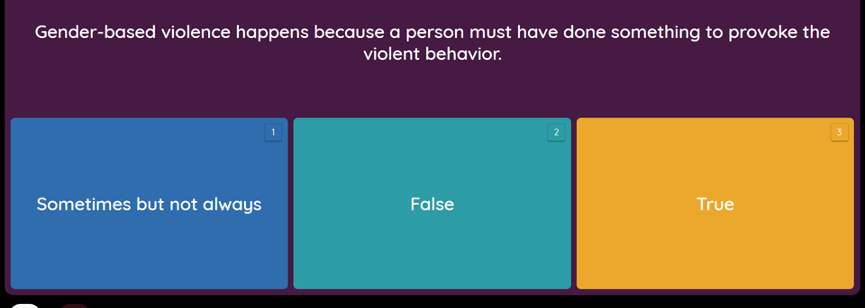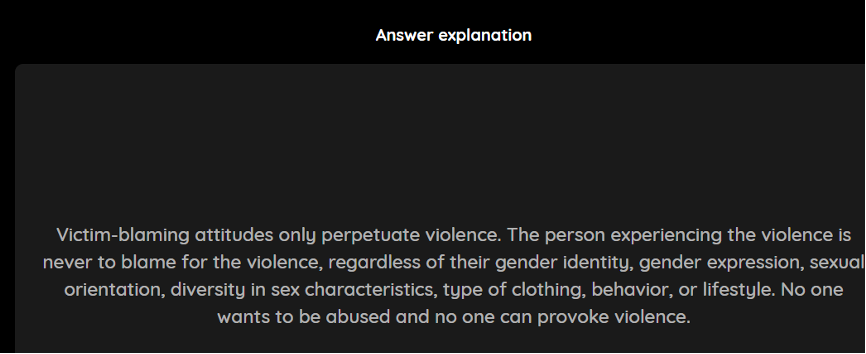
go to top
Module
Toolkit / Chapter 10 / Activity 10.03
Do you agree or disagree? Myths and realities about gender-based violence
Methodology adapted from the Manual Youth 4 Youth: A manual for empowering young people in preventing gender-based violence through peer education’ MIGS (2012)
Duration of activity: 45 min
Learning objectives:
- Encourage young people to self-analyse their own perceptions and attitudes on gender-based violence
- Help young people identify and explore certain myths that relate to gender-based violence.
- Create an open space for sharing thoughts, feelings and emotions about gender-based violence without judgement or shaming
- To set the ground for further work on recognizing, combatting and preventing gender-based violence
Materials needed:
- Enough space to move around the room without barriers.
- Papers with AGREE/DISAGREE writing, placed on two opposite sides of the room.
- The list of statements to read out, prepared in advance.
- Some chairs at opposite parts of the room, in case there are people who cannot spend much time standing.
Recommended prior reading:
- Section 5.2 Dealing with our own prejudices as trainers
- Section 5.4: Creating a safe, comfortable and inclusive space
- Section 5.6: Teaching about sensitive and controversial issues
- Section 5.7 : Dealing with difficult questions
- Section 5.8: How to respond to disclosure of violence
- Section 5.9: Further facilitate participants’ path to safety
- Section 7.4: Tips for engaging participants online (if applicable)
- Section 7.2: Creating a safe, welcoming space for participants online (if applicable)
Step by step process of the activity: (30 min)
- Divide the classroom floor in two ‘sections’, using a masking tape. On one side of the room put a sign with Agree written on it and on the other side put up a sign with Disagree.
- Explain to young people that you will read some statements. These statements are not right or wrong. What matters is their personal opinion. After they hear each statement, they need to decide if they ‘agree’ or ‘disagree’ and move to the respective area of the room . The stronger they agree, the closer they stand to “Agree” and similarly, the stronger they disagree, the closer they stand to ‘Disagree’. If they are feeling unsure or cannot decide, they can stand in the middle of the room, next to the dividing line. During the course of the activity participants can move places if they hear arguments that may encourage them to change their mind.
- Before you start reading the statements remind young people of the group agreement for safe space and explain that everyone has the right to express their opinion without being judged, put down or disrespected.
- Read the statements one by one. Ask the group not to speak until everyone has taken a position.
- Invite young people to support their ‘position’ by presenting their arguments (for agreeing, disagreeing or being unsure). Encourage a debate to be formed between them. Make sure the debate takes place in an orderly fashion so as to avoid things getting too chaotic.
- After the arguments have been presented, ask whether any young people feel they need to change their ‘position’
- Wrap up the discussion by summarizing some of the key points regarding gender- based violence.
| Take home messages and activity wrap up: Myths about gender-based violence generally blame the survivor of the violence or some other factor, such as alcohol, anger or mental illness in an effort to justify the abuser. As a result, these myths divert attention from the actions of the abuser who is responsible for the violent behaviour. Violence is about control and domination. Violent or abusive people make rational and conscious choices to be violent or abusive towards a person that they feel they have power over or more privileges or because they belong to a dominant group (dominant culture against ethnic minorities, persons with ability vs. people with disability, heterosexual vs. LGBTIQ+ people, cisgender over nonbinary/trans, men over women, most groups against sex workers, etc.). Understanding the myths and realities of gender-based violence can help us focus on the responsibility of the abuser and also on the responsibility we have as a society to challenge existing norms that give rise to this type of violence. |
| Tips for facilitators: It is important to move through the statements in a relatively fast manner, without letting the discussion on a specific statement drag on. This may get boring or demotivating for young people and they may lose interest. Once the arguments for both sides have been provided, and essentially no new arguments are presented, it a sign that you need to move on to the next statement. Don’t debrief after each statement, as it will get tiring for young people. Run a comprehensive debriefing session after all statements have been discussed. If young people are supporting or promoting stereotypes in their arguments, which are not challenged by opposing arguments, you can play the devil’s advocate and challenge them from your end. What is important is to try to widen young people’s perspectives (by challenging their perceptions and attitudes) so that they can start to question and rethink things that they have so far taken for granted or considered to be the norm. Because we’re opening up the issue of violence, it may ‘hit home’ for some of the participants, so it is important that in the end of the activity we provide a link to resources where young people can get support. |
| Tips for adapting the activity and follow up: Instead of using the agree/disagree method, you can give the list of statements as a handout and ask young people to work individually, identifying whether each statement represents a myth or a reality. Once all members of the group have finished, you can go through the statements one by one in plenary, discussing whether it is a myth or a reality and why. |
| Adapting the activity for online implementation ● Using Quizizz, Mentimeter, Slido or any other online quiz platform you’re comfortable with, you can create a digital quiz of the myths and realities. You may need to change the questions slightly so you can create more ‘debatable’ answers in order to highlight the complexity of the issues and generate a more in-depth discussion around the key messages (as these are outlined in the ‘Answers to the above’ section of the activity). Be selective of the statements you will use as too many statements will get tiring. ● If you’re using Quizizz, you have the option to include an explanation after each answer in order to provide a few key pointers that can also be used to wrap up the discussion on each point. ● If you would prefer not to use an online quiz, you could show the statements one by one on PowerPoint and ask the participants to vote on the spot either by using the thumps up icon or the poll function in some platforms, by either raising a finger/thump, or by raising a using a coloured piece of paper (blue for myth, green for reality for instance) or by using coloured effects in their background. ● Alternatively, you can turn the statements of myths and realities into a worksheet which can be sent via the chat so as the participants can work on it individually during the workshop (see worksheet below). After the participants complete the worksheet, you can discuss each statement in plenary. You can use some of the pointers noted under the section ‘Answers to the above’ to guide your discussion (see printouts below). ● When closing the activity, make sure you have a list of available resources, both online and offline that young people can use. ● If you’re also working asynchronously with your participants, you could also send them the worksheet prior to the workshop so that they can work on it on their own time. In this case, you would also need to follow up with some explanations on the answers using some of the pointers noted under the section ‘Answers to the above’ to guide your discussion. |



go to top